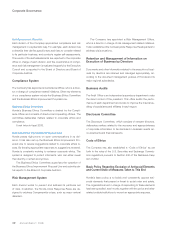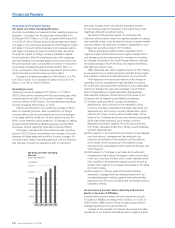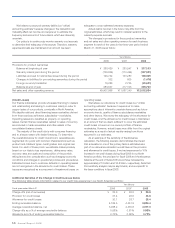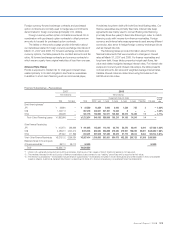Honda 2008 Annual Report Download - page 54
Download and view the complete annual report
Please find page 54 of the 2008 Honda annual report below. You can navigate through the pages in the report by either clicking on the pages listed below, or by using the keyword search tool below to find specific information within the annual report.
A n n u a l R e p o r t 2 0 0 8
5 2
The new models boast improved acceleration through a
combination of the PGM-FI electronic fuel injection system
with the world’s first ignition timing governed by Honda’s
original Boosted Low Speed Torque (BLAST) air-fuel ratio
technology. They also have improved fuel economy as a
result of the incorporation of a Lean Burn Control system for
cruising. In addition to these developments, in Japan, Honda
has begun to market its compound thin-membrane solar cell
modules HSPV-125A, HEM115PA, and HEM125PA, which are
formed around Honda’s originally developed thin membranes.
These modules employ membranes made from a Copper,
Indium, Gallium, and Selenium (CIGS) compound, which
makes it possible to conserve the amount of energy required
in the manufacturing stage.
Among other activities, GE Honda Aero Engines LLC, a
joint venture of Honda and General Electric Co., has begun
the testing of the HF-120 full demonstrator turbofan jet engine,
which is designed for volume production.
R&D expenses in this segment in fiscal 2008 totaled to
¥20.7 billion.
Fundamental Research
In the area of fundamental research, Honda is pursuing steady
and varied research activities into technologies that may lead
to innovative applications.
One of Honda’s research initiatives is the development
of a technological base for ethanol production from soft
biomass, including plant stalks and leaf matters, such as
rice straw. Honda has established a pilot plant within its
research facilities and is moving forward with R&D to establish
volume production technology. In the field of robotics and
ASIMO technology, Honda researchers are working on new
ASIMO intelligence and skill functions, including such motion
functions as moving back one step to allow human beings
to pass and passing to one side of human beings coming
from the opposite direction as well as work task functions,
such as carrying small latrines and pushing wagons. Other
ASIMO functions and systems under development include
proceeding automatically to a charging station when battery
power runs low and learning to perform cooperative functions
on a continuing basis, such as sharing work tasks among a
number of ASIMO robots when conditions are appropriate
and having other robots perform tasks in place of a robot that
is temporarily charging its battery.
Expenses incurred in fundamental research are
distributed among Honda’s business segments.
Capital Expenditures
Capital expenditures in fiscal 2008 were applied to the
expansion of manufacturing facilities, streamlining efforts,
and the replacement of older equipment. Other expenditures
included funds used to augment sales and R&D facilities.
Total capital expenditures for the year amounted to ¥1,493.2
billion, up ¥499.4 billion from the previous year. Also, total capital
expenditures excluding property on operating leases for the year
amounted to ¥654.0 billion, up ¥26.9 billion from the previous
year. Spending by business segment is shown below.
0
200
400
600
08_07_06_05_04_
0
2
4
6
08_07_06_05_04_ 0807060504
R&D Expenses and R&D Expenses
as a Percentage of Net Sales
Years ended March 31
(%))snoillib(neY
R&D Expenses (left)
R&D Expenses as a Percentage
of Net Sales (right)
0807060504
Fiscal years ended March 31,
2007 2008 Increase (Decrease)
Yen (millions)
Motorcycle Business ¥ 68,880 ¥ 86,687 ¥ 17,807
Automobile Business 540,859 544,922 4,063
Financial Services Business 367,728 839,888 472,160
Financial Services Business (Excluding Property on Operating Leases) 933 627 (306)
Power Product and Other Businesses 16,394 21,794 5,400
Total ¥993,861 ¥1,493,291 ¥499,430
Total (Excluding Property on Operating Leases) ¥627,066 ¥ 654,030 ¥ 26,964
In the motorcycle business, we made capital expenditures of
¥86,687 million in the fiscal year ended March 31, 2008. Funds
were allocated to the introduction of new models, as well as the
improvement, streamlining and modernization of production
facilities, and improvement of Sales and R&D facilities.
In the automobile business, we made capital expenditures
of ¥544,922 million in the fiscal year ended March 31, 2008.
Funds were allocated to the introduction of new models, as
well as the improvement, streamlining and modernization
of production facilities, and improvement of Sales and R&D
























